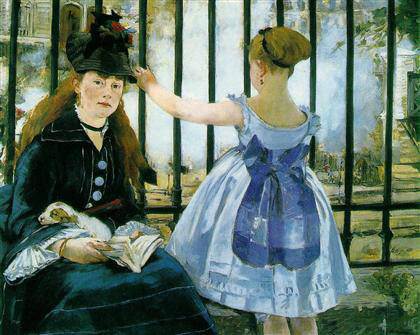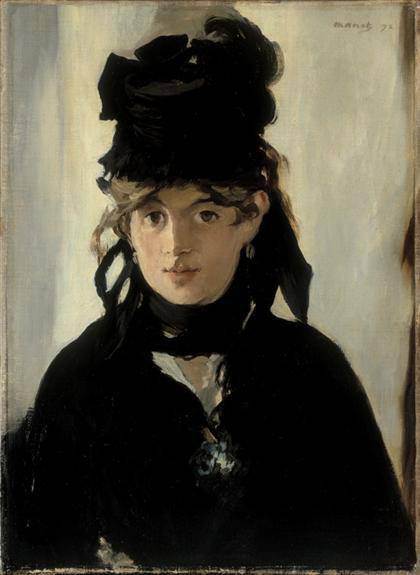
Edouard Manet, ‘The Railway‘, 1873.
Oil on canvas. 93.3 x 111.5 cm.
National Gallery of Art, Washington, Gift of Horace Havemeyer in memory of his mother, Louisine W. Havemeyer, 1956.10.1.
Photo courtesy of the National Gallery of Art, Washington.

Edouard Manet, ‘Berthe Morisot with a Bouquet of Violets‘, 1872.
Oil on canvas, 55.5 × 40.5 cm.
Musée d’Orsay, Paris. Acquis avec la participation du Fonds du Patrimoine, de la Fondation Meyer, de Chine Times Group et d’un mécénat coordonné par le quotidien Nikkei, 1998.
Photo © RMN (Musée d’Orsay) / Hervé Lewandowski
Manet: Portraying Life – Royal Academy of Arts The Royal Academy of Arts presents the first major exhibition in the UK to showcase Édouard Manet’s portraiture, examining the relationship between Manet’s portrait painting and his scenes of modern life. 26 January 2013 – 14 April 2013.]]>
Source: Royal Academy of Arts
The exhibition is arranged thematically, exploring Manet’s world and the landscape of nineteenth-century Parisian society. Different sections focus on” The Artist and his Family” – Manet, SuzanneLeenhof Manet and Léon Koëlla Leenhof; “Manet and his Artist Friends” including Berthe Morisot, EvaGonzalès and Claude Monet; “Manet and his Literary and Theatrical Friends” such as Emile Zola,Zacharie Astruc, Théodore Duret, George Moore, Stéphane Mallarmé and Fanny Claus; “StatusPortraits” including Georges Clemenceau, Henri Rochefort and Antonin Proust, and finally, “The Artistand his Models” which will encompass both female friends such as Méry Laurent and IsabelleLemonnier as well as professional models, such as Victorine Meurent.
Highlights includes “The Luncheon”, 1868 (Bayerische Staatsgemaldesammlungen–NeuePinakothek, Munich), depicting Léon, the son of Manet’s wife; “Mme Manet in the Conservatory”, 1879(The National Museum of Art, Architecture and Design, Oslo); “Berthe Morisot with a Bouquet of Violets”,1872 (Musée d’Orsay, Paris), “Street Singer”, c.1862 (Museum of Fine Arts, Boston), “Le Déjeuner surl’herbe”, c.1863-68 (The Courtauld Gallery, London), “The Railway”, 1873 (National Gallery of Art,Washington) and “Music in the Tuileries Gardens”, 1862 (The National Gallery, London) which bringstogether the literary and theatrical friends of the artist.
Édouard Manet was born in Paris in 1832 into a middle-class family. His father Auguste, was a seniorcivil servant in the Ministry of Justice, and his mother, Eugénie-Désirée, the daughter of a diplomat.Manet enlisted in the merchant marine and travelled to South America in 1848. A year after his returnto Paris in 1849, he entered the studio of the successful salon artist Thomas Couture and for the nextsix years, he pursued training within and beyond Couture’s studio. Exposure to contemporary art camethrough the Paris Salon and independent exhibitions. Manet’s independence of style, individuality of subject matter and seemingly non-conventionaltechnique meant that his exhibition career was fraught with rejection and on-going negative criticalresponse. However, despite supporting his younger contemporaries, the Impressionists, and observingclosely their own innovative approach to subject matter and technique, he resolutely refused to exhibitwith them in the eight Impressionist exhibitions (1874–1886).
Throughout his life, Manet surrounded himself with a wide circle of friends, admirers and supporters from the artistic, literary and musicalcommunities – all of whom professed leanings towards the more radical movements of the day; theydefended his art and served as sitters for his portraits. Manet’s career as a professional artist lastedless than three decades, cut short by his premature death in 1883 at the age of 51.
Related content
Musée d’Orsay presents ‘Manet, the man who invented Modernity’ (exhibition, 2011)
Follow us on:


